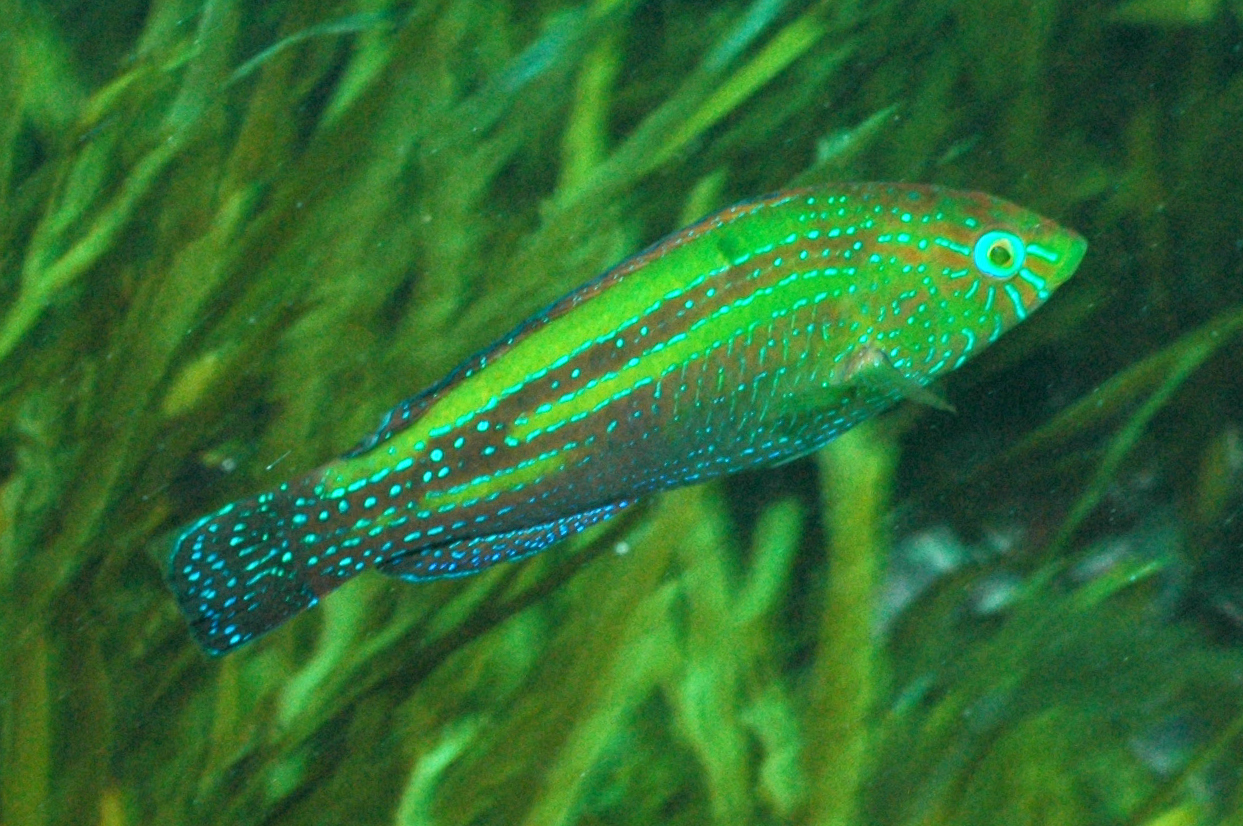False Senator Wrasse, Pictilabrus viridis Russell 1988

A False Senator Wrasse, Pictilabrus viridis. Source: Graham Edgar / Reef Life Survey. License: CC BY Attribution-Noncommercial
A small wrasse with different colour phases depending on its life stage. Juveniles and females are pale green with pale reddish bands along the sides, five or six narrow blue lines below eye, and a green spot between first three dorsal spines, and a black spot between last three dorsal soft rays. Adult males are similar, but with more intense colours, no spot at rear end of dorsal fin, and anal fin suffused with blue, reddish base.
False Senator Wrasse, Pictilabrus viridis Russell 1988
More Info
|
Distribution |
Endemic to southern Western Australia, from the Recherche Archipelago to Jurien Bay. Inhabits rocky reefs, usually in very shallow water in depths less than 5 m. Although very similar in appearance to the more widely distributed Senator Wrasse, this species generally occurs in shallower waters that are subject to surge from wave action. |
|
Features |
Meristic features: Dorsal fin IX, 11; Anal fin III, 10; Caudal fin 12; Pectoral fin 13; Pelvic fin I, 5; Lateral line scales 25. Body moderately deep (28-33% SL), compressed. Head moderately large (30-34% SL), dorsal profile convex; eyes moderately large (19-24% HL); mouth small, upper jaw not reaching as far as eye; teeth small, caniniform; anterior pair in upper jaw and anterior two pairs in lower jaw enlarged and recurved; each side of upper jaw with enlarged canine at rear. Scales moderately large, cycloid, firmly attached, covering body; head naked except for one to three rows of cheek scales and eight to ten large scales on opercle; lateral line abruptly curved downwards beneath last spines of dorsal fin. Dorsal fin continuous, with elongate base and uniform height; anal fin similar to and opposite rear half of dorsal fin; caudal fin truncate. Pectoral fins short, pointed, upper rays longest. Pelvic fins short, arising beneath pectoral fin bases, not reaching near anus. |
|
Size |
|
|
Colour |
Juveniles and females pale green with a pale reddish band on back above lateral line, a second band from behind pectoral fin joining with upper band below end of dorsal fin, a third band running along lower part of body from above middle of anal fin to base of tail; upper and lower margins of these bands edged with broken green lines. Head with five or six narrow blue lines below eye;. Dorsal and anal fins reddish with narrow green margins, a green spot between first three dorsal spines, and a black spot between last three dorsal soft rays. Caudal fin dusky red. Pectoral fins translucent yellow with a narrow black bar at base. Pelvic fins greenish. Adult males similar, but with more intense colours, no spot at rear end of dorsal fin, and anal fin suffused with blue, reddish base. |
|
Feeding |
|
|
Biology |
Like Picitilabrus laticlavius, this species is presumed to be a protogynous hermaphrodite, changing sex from female to male at some stage during its life. |
|
Fisheries |
|
|
Conservation |
|
|
Remarks |
|
|
Similar Species |
Differs from the Pictilabrus brauni in having the dorsal-fin membranes continuous, not incised, 10 soft anal-fin rays, a moderately deep body, 2.0–3.0 in SL, and no parallel bars on head (vs dorsal-fin membranes weakly incised, anal fin with 9 soft rays, body slender, 4.1–4.5 in SL, and 6 parallel blue bars on head). Pictilabrus viridis differs from Pictilabrus laticlavius in having the pectoral fins pointed, upper rays longest (vs rounded pectoral fins with the middle rays longest); males without dark bar on body but with distinct dark bar at base of each pectoral fin (vs males with a distinctive dark wedge-shaped bar on body behind pectoral fin and no bar or, at most, only an indistinct bar at base of each pectoral fin). |
|
Etymology |
The specific name viridis is from the Latin word for 'green', in reference to the mostly green body colour of the False Senator Wrasse. |
|
Species Citation |
Pictilabrus viridis Russell, 1988, Rec. Aust. Mus., Suppl. 9: 38, figs 8, 12-13, 15-18, 23, pl. 4E-F. Type locality: Lucky Bay, Cape Le Grande, Western Australia, 33°60'S, 122°14'E. |
|
Author |
Dianne J. Bray |
False Senator Wrasse, Pictilabrus viridis Russell 1988
References
Gomon, M.F. &. Russell, B.C. 1994. Family Labridae. pp. 675-699 in Gomon, M.F., Glover, C.J.M. & Kuiter, R.H. (eds). The Fishes of Australia's South Coast. Adelaide : State Printer 992 pp. 810 figs.
Hutchins, J.B. & S.M. Morrison. 1996. Pictilabrus brauni, a new species of labrid fish from South-western Australia. Revue française d'Aquariologie Herpétologie 23 (1-2): 39-42.
Kuiter, R.H. 2002. Fairy & Rainbow Wrasses and their Relatives. Chorleywood, U.K. : TMC Publishing 207 pp.
Russell, B.C. 1988. Revision of the labrid fish genus Pseudolabrus and allied genera. Records of the Australian Museum, Supplement 9: 1-72. PDF Open access
Russell, B. 2010. Pictilabrus viridis. In: IUCN 2013. IUCN Red List of Threatened Species. Version 2013.2. . Downloaded on 27 September 2013.
Russell, B.C. & Gomon, M.F. 2008. Family Labridae. pp. 638-659 in Gomon. M.F., Bray, D.J. & Kuiter, R.H (eds). Fishes of Australia's Southern Coast. Sydney : Reed New Holland 928 pp.




